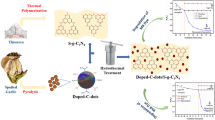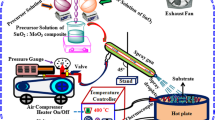Abstract
In the present work, we analyzed the electrochromic behavior of tungsten oxide (WO3) and effect of hafnium (Hf) doping on its performance. The electrochromic performance of pristine WO3 and (2, 5, 7, 10%) Hf-doped WO3 was tested in lithium and calcium electrolyte. Hf-doped outperformed the pristine WO3, and 7% doped sample showed best results. The performance was also affected by the electrolyte used. In Ca electrolyte, 7% Hf-doped WO3 exhibited highest optical contrast of 75% (714 nm), fast switching (1.28s tc/3.14s tb), and highest coloration efficiency of 161.87 cm2 C−1 of all the samples tested. A device fabricated from the 7% Hf-doped WO3 exhibited fast switching (1.53s tc/5.83s tb) and excellent stability and proved the practical applicability of Hf doped WO3/Ca electrolyte electrochromic system.









Similar content being viewed by others
References
Chen P-W, Chang C-T, Ko T-F et al (2020) Fast response of complementary electrochromic device based on WO 3 /NiO electrodes. Sci Reports 101(10):1–12. https://doi.org/10.1038/s41598-020-65191-x
Granqvist CG (2016) Recent progress in thermochromics and electrochromics: a brief survey. Thin Solid Films 614:90–96. https://doi.org/10.1016/J.TSF.2016.02.029
Singh R, Tharion J, Murugan S, Kumar A (2017) ITO-free solution-processed flexible electrochromic devices based on PEDOT:PSS as transparent conducting electrode. ACS Appl Mater Interfaces 9:19427–19435. https://doi.org/10.1021/ACSAMI.6B09476/SUPPL_FILE/AM6B09476_SI_003.AVI
Liu J, Daphne Ma XY, Wang Z et al (2020) Highly stable and rapid switching electrochromic thin films based on metal-organic frameworks with redox-active triphenylamine ligands. ACS Appl Mater Interfaces 12:7442–7450. https://doi.org/10.1021/ACSAMI.9B20388/ASSET/IMAGES/LARGE/AM9B20388_0003.JPEG
Madasamy K, Velayutham D, Suryanarayanan V et al (2019) Viologen-based electrochromic materials and devices. J Mater Chem C 7:4622–4637. https://doi.org/10.1039/C9TC00416E
Halder S, Roy S, Chakraborty C (2022) Multicolored and durable electrochromism in water soluble naphthalene and perylene based diimides. Sol Energy Mater Sol Cells 234:111429. https://doi.org/10.1016/J.SOLMAT.2021.111429
Zhang W, Li H, Yu WW, Elezzabi AY (2020) Transparent inorganic multicolour displays enabled by zinc-based electrochromic devices. Light Sci Appl 91(9):1–11. https://doi.org/10.1038/s41377-020-00366-9
Ling H, Wu J, Su F et al (2021) Automatic light-adjusting electrochromic device powered by perovskite solar cell. Nat Commun 121(12):1–8. https://doi.org/10.1038/s41467-021-21086-7
Granqvist CG (1993) Electrochromic materials: Microstructure, electronic bands, and optical properties. Appl Phys A 1993 571 57:3–12. https://doi.org/10.1007/BF00331209
Yuan G, Hua C, Huang L et al (2017) Optical characterization of the coloration process in electrochromic amorphous and crystalline WO3 films by spectroscopic ellipsometry. Appl Surf Sci 421:630–635. https://doi.org/10.1016/J.APSUSC.2016.10.176
Lokhande VC, Lokhande AC, Lokhande CD et al (2016) Supercapacitive composite metal oxide electrodes formed with carbon, metal oxides and conducting polymers. J Alloys Compd
Yuan G, Hua C, Khan S et al (2018) Improved electrochromic performance of WO3 films with size controlled nanorods. Electrochim Acta 260:274–280. https://doi.org/10.1016/J.ELECTACTA.2017.10.193
Yao Y, Zhao Q, Wei W et al (2020) WO3 quantum-dots electrochromism. Nano Energy 68:104350. https://doi.org/10.1016/J.NANOEN.2019.104350
Zhang S, Cao S, Zhang T et al (2018) Al3+ intercalation/de-intercalation-enabled dual-band electrochromic smart windows with a high optical modulation, quick response and long cycle life. Energy Environ Sci 11:2884–2892. https://doi.org/10.1039/C8EE01718B
Wang WQ, Yao ZJ, Wang XL et al (2019) Niobium doped tungsten oxide mesoporous film with enhanced electrochromic and electrochemical energy storage properties. J Colloid Interface Sci 535:300–307. https://doi.org/10.1016/J.JCIS.2018.10.006
Xie S, Bi Z, Chen Y et al (2018) Electrodeposited Mo-doped WO3 film with large optical modulation and high areal capacitance toward electrochromic energy-storage applications. Appl Surf Sci 459:774–781. https://doi.org/10.1016/J.APSUSC.2018.08.045
Yin Yi, Gao Tian, Qingfan Xu et al (2020) Electrochromic and energy storage bifunctional Gd-doped WO 3 /Ag/WO 3 films. J Mater Chem A 8:10973–10982. https://doi.org/10.1039/D0TA02079F
Lokhande VC, Hussain T, Shelke AR et al (2021) Substitutional doping of WO3 for Ca-ion based supercapacitor. Chem Eng J 424:130557. https://doi.org/10.1016/J.CEJ.2021.130557
Habtemariam AB, Alemu Y (2021) Synthesis of WO3 nanoparticles using Rhamnus Prinoides leaf extract and evaluation of its antibacterial activities. Biointerface Res Appl Chem 12:529–536. https://doi.org/10.33263/BRIAC121.529536
Kwong WL, Koshy P, Hart JN et al (2018) Critical role of 002 preferred orientation on electronic band structure of electrodeposited monoclinic WO3 thin films. Sustain Energy Fuels 2:2224–2236. https://doi.org/10.1039/C8SE00239H
Huang YB, Luo YJ, Wang F (2019) Hafnium-doped mesoporous silica as efficient Lewis acidic catalyst for friedel–crafts alkylation reactions. Nanomaterials, 9:1128. Hafnium-doped mesoporous silica as efficient Lewis acidic catalyst for Friedel-Crafts alkylation reactions. Nanomater 9:1128. https://doi.org/10.3390/NANO9081128
Li J, Liu Y, Zhu Z et al (2013) A full-sunlight-driven photocatalyst with super long-persistent energy storage ability. Sci Rep 3:2409. https://doi.org/10.1038/srep02409
Bazarjani MS, Hojamberdiev M, Morita K et al (2013) Visible light photocatalysis with c-WO3–x/WO3×H2O nanoheterostructures in situ formed in mesoporous polycarbosilane-siloxane polymer. J Am Chem Soc 135:4467–4475. https://doi.org/10.1021/JA3126678
Guo Chongshen, Yin Shu, Dong Qiang, Sato Tsugio (2012) The near infrared absorption properties of W 18 O 49. RSC Adv 2:5041–5043. https://doi.org/10.1039/C2RA01366E
Piallat F, Beugin V, Gassilloud R et al (2014) Interface and plasma damage analysis of PEALD TaCN deposited on HfO2 for advanced CMOS studied by angle resolved XPS and C-V. Appl Surf Sci 303:388–392. https://doi.org/10.1016/J.APSUSC.2014.03.011
Liu C, Tang XG, Wang LQ, Tang H, Jiang YP, Liu QX, Tang ZH (2019) Resistive switching characteristics of HfO2 thin films on mica substrates prepared by Sol-Gel process. Nanomaterials 9:1124. https://doi.org/10.3390/NANO9081124
Wu LQ, Li YC, Li SQ et al (2015) Method for estimating ionicities of oxides using O1s photoelectron spectra. AIP Adv 5:097210. https://doi.org/10.1063/1.4931996
XPS Interpretation of Hafnium. https://www.jp.xpssimplified.com/elements/hafnium.php. Accessed 31 Oct 2021
X-ray photoelectron spectroscopy (XPS) Reference Pages: Hafnium. http://www.xpsfitting.com/2008/09/hafnium.html. Accessed 31 Oct 2021
Cai G, Cui M, Kumar V et al (2016) Ultra-large optical modulation of electrochromic porous WO3 film and the local monitoring of redox activity. Chem Sci 7:1373–1382. https://doi.org/10.1039/C5SC03727A
Liu L, Layani M, Yellinek S et al (2014) “Nano to nano” electrodeposition of WO3 crystalline nanoparticles for electrochromic coatings. J Mater Chem A 2:16224–16229. https://doi.org/10.1039/C4TA03431G
Zhang J, Tu J, Xia X et al (2011) Hydrothermally synthesized WO3 nanowire arrays with highly improved electrochromic performance. J Mater Chem 21:5492–5498. https://doi.org/10.1039/C0JM04361C
Cong S, Tian Y, Li Q et al (2014) Single-crystalline tungsten oxide quantum dots for fast pseudocapacitor and electrochromic applications. Adv Mater 26:4260–4267. https://doi.org/10.1002/ADMA.201400447
Zhou J, Wei Y, Luo G et al (2016) Electrochromic properties of vertically aligned Ni-doped WO3 nanostructure films and their application in complementary electrochromic devices. J Mater Chem C 4:1613–1622. https://doi.org/10.1039/C5TC03750F
Cai G, Wang X, Zhou D et al (2013) Hierarchical structure Ti-doped WO3 film with improved electrochromism in visible-infrared region. RSC Adv 3:6896–6905. https://doi.org/10.1039/C3RA40675J
Acknowledgements
This work was supported by the Basic Science Research Program through the National Research Foundation of Korea (NRF) funded by the Ministry of Education under Grant 2021R1F1A104994711.
Author information
Authors and Affiliations
Corresponding author
Additional information
Publisher's Note
Springer Nature remains neutral with regard to jurisdictional claims in published maps and institutional affiliations.
Rights and permissions
About this article
Cite this article
Kim, C., Lokhande, V., Youn, D. et al. Electrochromism in Hf-doped WO3. J Solid State Electrochem 26, 1557–1566 (2022). https://doi.org/10.1007/s10008-022-05187-x
Received:
Revised:
Accepted:
Published:
Issue Date:
DOI: https://doi.org/10.1007/s10008-022-05187-x




